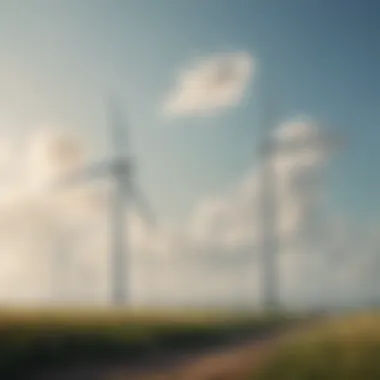Pros and Cons of Green Energy Sources Explained


Intro
The discussion surrounding green energy is becoming ever more pressing as global challenges related to climate change and resource depletion unfold. With the rising stakes, understanding the intricacies of renewable energy offers valuable insights for a variety of stakeholders. This section aims to highlight the key points that will be elaborated upon in the following narrative.
Green energy broadly encompasses sources such as solar, wind, hydroelectric, and geothermal. Each of these alternatives offers distinct benefits and hurdles that have significant implications on the environment, economy, and society as a whole. A balanced understanding requires a dive into not only the advantages, likened to fresh air after a long flight, but also the limitations that can come alongside these promising solutions.
Consider the recent shift in investment trends, where institutional investors increasingly favor renewable resources. Investors are diving into this sector not just for ethical alignment, but also with a keen eye on returns. But, as with any investment, there are layers to peel back. What are the costs compared to traditional energy sources? What technological advancements are on the horizon that may shift the playing field?
It is not merely a question of profitability; we must delve into the environmental impact of transitioning to these alternatives.
The narrative progresses by evaluating the intricacies of economic considerations, technological advancements, and the societal implications intertwined with the adoption of green energy.
"Sustainable energy is not just a trend; it’s a necessity in the times we live in. Understanding its breadth and depth is critical for everyone."
With this overview, we will lay the groundwork for a comprehensive analysis of the advantages and disadvantages of green energy, enabling readers to navigate the complexities of this vital topic with clarity and intent.
Understanding Green Energy
Understanding green energy is paramount in today's world, particularly as we navigate through the complexities of sustainability. This section serves as a foundational stone, examining not just what green energy is, but the broader implications it carries for our environment, economy, and society. There is a distinct advantage in grasping the nuances of renewable energy sources—this information empowers communities, businesses, and governments to make informed choices.
Green energy provides a pathway to reduce our dependency on fossil fuels, which are notorious for their environmental impact, such as air pollution and global warming. By engaging in this discourse, we learn about cleaner alternatives that contribute to a healthier planet. Moreover, understanding these energy forms leads to conversations about their viability and the balance between innovation and responsibility.
Definition and Scope
Green energy refers to energy derived from natural sources that are replenished at a faster rate than they are consumed. This includes sunlight, wind, rain, tides, waves, geothermal heat, and biomass. The scope of green energy is quite broad as it encompasses various methods of harnessing energy that minimizes ecological damage.
An acquaintance with this definition allows stakeholders—from policy makers to the common individual—to consider how energy production can occur with minimal disruption to the earth's ecosystems. It sets the stage for discussions about transitioning economies away from traditional energy sources.
Types of Green Energy Sources
When discussing renewable energy, several key types come to the forefront, each with unique attributes and potential. Understanding these options helps pinpoint where industries and communities can adapt more sustainable practices.
Solar Energy
Solar energy is derived from sunlight, captured through photovoltaic cells or solar thermal systems. Its contribution is significant as it can power homes and businesses across the globe. One key characteristic is its versatility; solar panels can be installed on rooftops, in fields, or integrated into building designs. This adaptability makes it a beneficial choice in varied contexts. Moreover, the ability to generate electricity during peak sunlight hours aligns with high energy demands, providing a seamless energy solution. However, the initial costs for residential solar panels can be hefty, and efficiency can drop on cloudy days, raising concerns about reliability.
Wind Energy
Wind energy harnesses the kinetic energy from wind to generate power through turbines. Its principal characteristic is that it is entirely renewably sourced and has a lower carbon footprint compared to fossil fuels. Wind farms can be established both onshore and offshore, maximizing land use potential. The major advantage is the consistent energy output as long as wind conditions are favorable; however, wind energy is intermittent and can be unpredictable at times, leading to concerns about energy security during calm weather.
Hydropower
Hydropower, or hydroelectric power, depends on flowing water to generate energy. It has been around for centuries and continues to be a significant player in the renewable field. The key feature of hydropower is its efficiency and reliability; currently, it produces a substantial share of the world's electricity. The downside is the environmental impact of damming rivers, which can disrupt local ecosystems and displace communities. The trade-offs here are significant, requiring careful consideration of future projects.
Geothermal Energy
Geothermal energy harnesses the heat stored beneath the Earth's surface, typically utilized for electricity generation or direct heating applications. This energy form stands out for its constant availability—unlike solar or wind, it's not reliant on weather conditions. Geothermal sites can provide baseload power, making it a highly reliable choice. Nonetheless, geographic limitations exist; hot spots for geothermal sources aren't uniformly distributed, and drilling can come with risks and expenses that limit widespread implementation.
Biomass Energy
Biomass energy originates from organic materials, such as plant and animal waste. The essential aspect of biomass is its potential to transform waste into useful energy. It addresses waste management issues while contributing to energy production—a notable double benefit. However, large-scale biomass production can lead to land use changes and the risk of deforestation, impacting biodiversity.
In essence, understanding these different types of green energy sources equips us with knowledge about their functions, advantages, and challenges. This awareness is critical as we strive towards sustainable practices in energy consumption.
Environmental Benefits
The environmental advantages of green energy are crucial in today’s world, where climate change looms large over global concerns. Adopting renewable energy sources not only contributes significantly to reducing pollution but also helps conserve finite resources. Green energy technologies offer promising pathways for mitigating environmental decline while encouraging sustainable practices in various sectors. Understanding these benefits deepens our grasp on why transitioning towards greener alternatives is a pressing necessity for the planet's health and sustainability.
Reduction of Greenhouse Gas Emissions
One of the most compelling reasons to pivot towards green energy is its pivotal role in decreasing greenhouse gas emissions. Traditional energy sources, primarily fossil fuels like coal, oil, and natural gas, emit a plethora of harmful gases when burned. These emissions, such as carbon dioxide, methane, and nitrous oxide, are notorious for trapping heat in the atmosphere, leading to global warming.
Green energy sources, like solar and wind, generate electricity without releasing these gases. For instance, wind energy converts kinetic energy from air currents into electricity, while solar panels use sunlight for power generation, both avoiding combustion
This effective reduction in emissions can significantly assist countries in meeting their climate targets as outlined in international agreements like the Paris Agreement. Transitioning to renewables can lead to:


- Cleaner air quality: Fewer emissions mean lower air pollution, resulting in healthier communities.
- Less dependency on polluting fossil fuels: Promotes energy independence while helping curb the supply chain impacts associated with oil and gas extraction.
- Mitigation of climate change effects: Contributes to stabilizing weather patterns through lowered greenhouse gas concentrations.
As more regions boost their clean energy capacities, the overall impact becomes evident—green energy is swiftly rounding up the corners of the environmental degradation that has long plagued society.
Conservation of Natural Resources
In addition to reducing greenhouse gas emissions, green energy offers substantial benefits in the context of conserving natural resources. Traditional energy extraction methods often lead to severe ecological disturbances, affecting biodiversity and leading to resource depletion. Not to mention, proven practices like deep-sea drilling and extensive coal mining have left scars on Mother Nature.
Renewable energy technologies focus on harnessing naturally replenishing resources like sunlight, wind, and water flow. Hydropower, for example, leverages flowing water to generate electricity while, ideally, maintaining the natural ecosystem.
The potential benefits include:
- Sustainable resource management: Utilizing renewable sources which regenerate naturally reduces the strain on finite materials.
- Preservation of ecosystems: Minimizing disruptive extraction practices can help protect habitats and promote biodiversity.
- Optimized land use: Implementing solar farms and wind turbines on already disturbed lands or rooftops can create energy without further encroaching on natural landscapes.
The transition to green energy is not just an environmentally sound choice; it is a critical investment in the sustainability of our planet’s resources.
By taking these considerations into account, stakeholders can reevaluate their energy generation strategies, aligning them with innovations that respect and protect the very fabric of our natural world.
Economic Impact
The economic implications of green energy are at the heart of the broader discussion surrounding sustainability. When diving into this topic, one must consider not just the immediate advantages but also the long-range impacts it has on local and global economies. As the world shifts towards renewable sources, understanding this transformation is crucial for investors and professionals alike. The relationship between green energy and the economy is multifaceted, encompassing job growth, cost efficiency, investment opportunities, and ultimately the resilience of our financial systems against fluctuating fossil fuel markets.
Job Creation in the Renewable Sector
One of the standout benefits of the green energy initiatives is job creation. The renewable energy sector is like a breath of fresh air for economies around the world. Unlike traditional fossil fuels, which often rely on rigs and mines that require heavy machinery and capital investments, renewable energy sources such as solar and wind are labor-intensive. This demands a workforce that can design, install, and maintain these systems.
For instance, the solar energy industry has witnessed significant growth in employment opportunities. According to the Solar Foundation, more than 250,000 people were employed in the solar sector in recent years in the United States alone. The green energy landscape is not just about manufacturing; it encompasses R&D, engineering, and sales, creating a spectrum of job roles that did not exist a couple of decades ago. Notably, these jobs can often be more resilient to economic downturns as they are tied to ongoing investments in infrastructure and technology, rather than commodity prices.
Furthermore, the opportunities in renewable energy are not limited to high-skilled positions. Entry-level jobs in this sector can provide pathways for workers in communities that may not have had access to such prospects previously. It’s a powerful development, helping to stimulate local economies and foster a new generation of skilled labor.
Long-term Cost Savings
When considering green energy, one cannot ignore the aspect of long-term cost savings. While the initial investments in renewable technologies can be steep, the mathematics often works out in their favor over time. Investments in solar and wind power typically lead to lower utility bills and energy costs for consumers and businesses alike.
To illustrate, take the example of solar panels installed in a residential setting. Homeowners may face several thousand dollars in upfront costs, but these costs are increasingly offset by tax incentives and rebates available to those that opt for solar energy. Furthermore, as electricity prices rise, the savings accrued over the lifespan of solar panels, which can be upwards of 25 years, vastly exceed the initial expense. According to data from the Lazard Levelized Cost of Energy Analysis, the cost of solar energy has dropped by 89% over the last decade, further enhancing its appeal as a cost-saving measure.
Additionally, with green technologies designed for efficiency, businesses can benefit from reduced operational costs. This allows companies to allocate resources more effectively, investing in growth rather than being at the mercy of volatile energy prices. Buying energy from renewable sources can be as predictable as clockwork, creating a stable financial environment for budgeting and future planning.
"Adopting green energy solutions is not just a choice for today’s society but an investment in a more sustainable and economically stable future."
In essence, the economic impact of green energy transcends mere costs; it revolves around the creation of robust job markets and long-term savings that dissolve the initial investment concerns. The transition to renewable energy not only serves environmental interests but also fuels economic growth and enhances energy security. This brings us back to the core idea: evaluating the advantages and disadvantages means understanding both the immediate gains and long-term shifts this sector brings, establishing a foundation for future investment and innovation.
Technological Innovations
Technological innovations are a driving force behind the progress and acceptability of green energy sources. These advancements not only enhance the efficiency of renewable energy systems but also address some of the inherent challenges faced by this sector. The focus on innovation is crucial, especially in a world that is increasingly turning its back on fossil fuels in favor of sustainable alternatives. This involves a mix of cutting-edge research, practical applications, and the integration of new technologies that can redefine how energy is harnessed and utilized.
Efforts in innovation cover the spectrum of renewable energy sources from solar panels to wind turbines and beyond. More specifically, two primary areas of innovation deserve particular attention:
- Advancements in Energy Storage
- Efficiency Improvements in Energy Conversion
Advancements in Energy Storage
Energy storage technology has made remarkable strides in recent years. Traditionally, one of the biggest obstacles in relying on renewable energy has been its intermittency. For instance, solar energy generation peaks during midday but drops off sharply when the sun sets. This inconsistency creates a challenge for maintaining a stable energy supply. Advances in battery technology, like lithium-ion and flow batteries, have been at the forefront of solving this issue.
- Lithium-Ion Batteries: These batteries are widely used in electric vehicles and renewable energy storage systems. They are efficient, have a relatively long lifespan, and are increasingly becoming more affordable.
- Flow Batteries: These represent a newer technology that allows for scalable energy storage. They work by pumping liquid electrolyte solutions through electrodes, which makes them suitable for larger installations.
As these technologies mature, the reliability of green energy increases significantly, making it a more attractive option for investors and consumers alike. Further, improvements in energy density and reduction in costs make it possible for households and businesses to harness and store their own renewable energy, thereby decreasing reliance on grid power.
"Effective energy storage is the linchpin in the successful widespread adoption of renewable energy systems. Without it, many of the expected benefits may remain unrealized."
Efficiency Improvements in Energy Conversion
Enhancing the efficiency of energy conversion processes transforms how power is produced and consumed. Whether it's through refining solar panel design or improving wind turbine aerodynamics, these enhancements play a vital role in maximizing the output from renewable energy sources.
- Solar Energy Conversion: Modern photovoltaic cells use advanced materials and designs that capture sunlight more effectively than earlier iterations. For instance, bifacial solar panels can capture sunlight from both sides, significantly increasing energy output.
- Wind Turbine Technology: Today's wind turbines are taller, have longer blades, and utilize advanced control systems that optimize their performance in real-time. This means they can harness more wind energy even in areas with lower wind speeds.
These innovations do not just benefit producers but can also lower costs for consumers, stimulating further adoption and investment in renewable technologies. Moreover, with the global push toward sustainability, these efficiency upgrades may offer promising returns in terms of both financial investments and environmental impact.


Societal Implications
The discussion surrounding green energy often overlooks the societal implications which are key to understanding its broader impact on communities and individuals. Societal implications encompass how renewable energy sources interact with social structures, affect community dynamics, and contribute to a more sustainable living environment. With society facing pressing challenges like climate change and energy inequality, it becomes crucial to dissect the various facets of how green energy fits into these conversations.
Community Engagement and Education
Communities play a pivotal role in adopting green energy solutions. Engaging the community, from grassroots initiatives to public forums, allows for a better understanding of what green energy entails. For instance, local workshops that explain the benefits of solar panels can demystify the technology and address concerns. When communities actively participate in discussions about energy sources, it leads to increased awareness and interest in sustainable practices.
Moreover, education serves as a cornerstone for empowering communities. School programs focusing on renewable energy can instill an understanding of sustainability from a young age. This can evolve into community-driven projects, such as neighborhood solar co-ops, where residents come together to invest in solar power collectively. Such initiatives not only educate but also provide a sense of ownership and collective responsibility toward the environment.
A study highlighted in Britannica shows that communities engaged in renewable energy initiatives reported higher levels of satisfaction and commitment to sustainability. Engagement fosters an environment where individuals feel they are part of something bigger, thus enhancing social connectivity.
Equity and Access to Renewable Technologies
As society shifts toward greener energy sources, equity in access becomes paramount. Not all individuals or communities have the same ability to invest in or benefit from renewable technologies. Urban areas might have better access to resources like wind farms or solar installations compared to rural locations.
This disparity raises questions about fairness in energy transition. Policymakers need to address barriers that prevent equitable access. Initiatives such as subsidies for low-income families can help in alleviating the financial burdens associated with initial investments in renewable energy. These actions might include incentives for installing solar panels among low-income households, creating a more balanced landscape in energy production and consumption.
Moreover, ensuring broad access to renewable technologies means not just economic considerations. It also involves understanding cultural sensitivities and local needs, aligning technologies with the community's ways of life. For example, in areas where biomass is commonly used for cooking, transitioning to more efficient forms of biomass energy can significantly improve air quality while respecting local traditions.
Challenges of Green Energy
One major aspect of these challenges includes the intermittency of supply, which refers to the unpredictable availability of renewable energy sources like solar and wind. Unlike traditional energy sources that can be harnessed continuously, solar power relies on sunlight and wind energy depends on—well—wind. This variability can lead to significant fluctuations in energy supply, which complicates the reliability and stability of the electrical grid. Take for instance a sunny day when solar panels might be cranking out energy at maximum capacity. The next day, if clouds roll in, that output could take a nosedive just like that. This inconsistency necessitates innovative solutions for energy storage and grid management to keep the supply steady and reliable.
Intermittency of Supply
The intermittency challenge is indeed a double-edged sword. On one hand, it showcases the limitations of renewable energy in replacing fossil fuels. On the other hand, it also highlights the incredible innovation happening in this sector. Technologies such as batteries and other storage solutions hold promise for mitigating these supply inconsistencies.
Here are some factors to consider:
- Grid Dependence: Many regions still heavily rely on fossil fuels. When the sun doesn't shine or the wind dies down, these traditional energy sources can step in, making the transition tricky.
- Forecasting Difficulties: Energy generation from renewables is often hard to predict. Lack of precise forecasting can lead to either overproduction or underproduction, affecting pricing and grid stability.
Given these complexities, there is a growing focus on developing more responsive energy systems that can switch between various sources seamlessly, reducing reliance on any single type.
High Initial Investment Costs
Another significant hurdle is the high initial investment costs associated with green energy technologies. While the long-term savings can be alluring, the upfront expenditure can be a dealbreaker for many investors and developers. Take solar panels, for example: the cost of manufacturing and installing them can be substantial, which might deter installations in areas where the immediate return on investment isn't evident.
A few points to emphasize here:
- Capital Investment: Building renewable infrastructure often requires capital investment that can be five times higher than traditional energy sources. This can present tough challenges, particularly for developing regions.
- Return on Investment: Despite the potential for long-term cost savings, the payback period can be lengthy. Some consumers find it hard to justify such a long waiting time, especially when energy prices fluctuate and competition from fossil fuels remains fierce.
- Policy and Incentives: Governmental subsidies or incentives can help alleviate some initial costs, but this varies widely by region. The lack of uniform global support means that renewable projects can struggle in less favorable economic conditions.
In summary, while green energy represents a beacon of hope, the road to a sustainable energy future is lined with challenges that can’t be ignored. Addressing the issues of supply intermittency and high investment costs requires forethought and innovative solutions to ensure the reliable transition from fossil fuels. Viewed through the lens of opportunity, these challenges call for creativity and resilience from all stakeholders in the energy sector.
"Green energy is not just a trend; it is a cornerstone of future energy strategy. Understanding its challenges empowers us to think critically about how we can address them."
In discussing these challenges, it sheds light on the critical importance of adaptive strategies and robust support systems that will help navigate the complexities of creating a sustainable energy landscape.
Market Dynamics
In the world of green energy, market dynamics play a pivotal role in shaping the landscape of both supply and demand. Understanding these dynamics is crucial for various stakeholders including investors, policymakers, and consumers. The fluctuations in energy prices directly affect how renewable energy is perceived and utilized, guiding investment decisions and policy-making. Moreover, the presence and availability of subsidies and incentives can either spur growth or stifle innovation in the renewable sector. Evaluating these elements provides insight into the broader implications of green energy choices in a fluctuating economic environment.
Fluctuations in Energy Prices
Energy prices are not static; they dance to the tune of market needs, supply chains, and geopolitical factors. As renewable energy gains traction, the prices of traditional energy sources like oil and coal begin to ebb and flow in response. This cat-and-mouse game can have several impacts:
- Market Competitiveness: When the price of fossil fuels dips, renewable energy sources can find themselves squeezed, making it harder for them to compete. On the flip side, rising fossil fuel prices can make renewables more appealing.
- Investment Shifts: Investors keep a close eye on energy prices. Sudden spikes or drops can influence decisions on where to allocate funds. If investors see the potential for lower prices in fossil fuels, they may hesitate to invest in long-term renewable projects.
- Consumer Behavior: Changes in prices can also affect how consumers engage with their energy consumption habits, possibly affecting the demand for green products or initiatives.
Though the journey of energy prices can feel like a rollercoaster, understanding these fluctuations is essential for making informed decisions in the green energy sector.
Subsidies and Incentives for Renewables
Subsidies and incentives act as a lifeboat for green energy developers navigating the rough waters of an ever-changing market. They can provide the necessary boost to encourage adoption and innovation. Some key aspects include:
- Financial Support: Governments often offer tax breaks, grants, and subsidies to lower the financial barrier for renewable energy projects. For instance, solar panel installations might be eligible for significant tax credits, making them more accessible to a wider audience.
- Market Signals: Incentives send a clear signal to the market about the government's commitment to renewable energy. This can attract both national and international investors who are keen on supporting sustainable initiatives.
- Innovative Financing Options: Various programs, such as feed-in tariffs, guarantee renewable energy producers a fixed price for the energy they generate. This can provide more predictability in revenues, enticing more players to enter the field.
"Incentives bridge the gap between cost and consumer acceptance, making renewable technologies not just viable but essential for sustainable development."


Global Perspectives on Green Energy
The discussion around green energy is not just limited to its environmental or economic impacts; it also encompasses a variety of global perspectives that highlight its significance and implications on a worldwide scale. As different regions grapple with the effects of climate change and energy demands, understanding these global nuances is critical.
Given the interdependence of countries in the age of climate crisis, analyzing green energy from a global perspective helps illuminate the varied approaches, successes, and setbacks that nations encounter in adopting these technologies.
Adoption rates of renewable energy sources, especially in developing countries, can vary widely based on economic conditions, policy frameworks, and societal attitudes. This variance is significant when considering the overall move towards sustainable energy practices compounded with international agreements that can either facilitate or hinder this transition.
Adoption Rates in Developing Countries
Developing countries often face unique challenges and opportunities when it comes to adopting green energy solutions. Factors such as limited access to capital, infrastructural constraints, and varying governmental policies can considerably shape the adoption landscape.
While it's easy to can look at these countries through a lens of limitation, it's important to recognize the vast potential they possess. For instance, in nations like Kenya, the uptake of solar energy in rural areas has been remarkable. Many communities are leapfrogging traditional energy systems straight to renewable sources, which underscores a crucial point: technological innovation does not always come from wealthier nations.
- Pros of Adoption
- Enhanced energy access for remote areas
- Reduction in reliance on imported fuels
- Local job creation in the renewable sector
However, challenges persist, including political instability, which can jeopardize long-term investments. Furthermore, financial resources from international partners are crucial in addressing these gaps, yet they can sometimes come with strings attached that may not align perfectly with local needs.
International Policies and Agreements
The role of international policies in shaping green energy initiatives cannot be overstated. Agreements such as the Paris Accord aim to unite countries in their fight against climate change, encouraging commitments to reduce greenhouse gases and adopt cleaner energy.
However, the implementation of such agreements can appear inconsistent. Some nations are quick to adapt, while others lag behind, often due to political or economic circumstances. Consider how the European Union has implemented strict regulations and incentives for renewable energy adoption, contrasting sharply with countries that face political turmoil or lack the necessary infrastructure.
"The fight against climate change knows no borders; the effectiveness of policies thus largely hinges on international collaboration and mutual accountability."
Inclusion in international discussions and commitments can propel a country’s green energy initiatives, motivating domestic policy reforms aligned with global goals. Notably, developing nations are frequently at the forefront of these discussions to secure funding and technology transfers from developed countries.
In summary, global perspectives on green energy not only emphasize the diverse approaches taken by different nations but also underline the critical need for collaborative efforts. As countries strive to overcome local challenges, they also engage in the larger conversation about sustainability and environmental responsibility on a global stage.
Future Outlook for Green Energy
The landscape of energy consumption is shifting markedly, with green energy becoming a focal point for future planning. Focusing on the future outlook for green energy helps us to understand both opportunities and risks that lie ahead. The world is quickly experiencing the effects of climate change, which pushes governments, industries, and individuals to reconsider their energy use. By examining future predictions about renewable energy and the influence of innovation and research, stakeholders can prepare for a sustainable energy framework that is not only environmentally friendly but also economically viable.
Predictions for Renewable Energy Expansion
Predictions concerning renewable energy expansion are becoming ever more optimistic. Global investments in green technology are ramping up, and market projections indicate a robust compound annual growth rate. Here are a few key trends to watch for:
- Increased Capacity: By 2030, the International Energy Agency suggests that renewable energy capacity could triple, potentially satisfying nearly half of the world's electricity needs.
- Technological Advancements: Technologies in solar panels and wind turbines are constantly evolving, leading to higher efficiencies and lower costs. For example, bifacial solar panels reportedly can generate up to 27% more electricity compared to traditional models due to their ability to capture sunlight on both sides.
- Decentralized Energy Models: The traditional model of energy production is shifting to decentralized systems. This means more homeowners might install solar panels, leading to a more localized grid management.
"The real game-changer will be the combination of decentralized production and smart grids, enabling dynamic energy management at local levels."
The Role of Innovation and Research
Innovation plays a pivotal role in the landscape of green energy. Research and development are crucial as they fuel the advancement of technologies that can drive down costs, improve reliability, and enhance performance. Several key areas of focus include:
- Energy Storage Solutions: As renewable sources like solar and wind generate energy intermittently, storage technologies are fundamental. Innovations in battery technology, like lithium-sulfur batteries, show promise in boosting energy storage capacity drastically.
- Smart Grids: The integration of smart grid technologies allows for more efficient energy monitoring and management. These systems can provide real-time data, helping to balance supply and demand effectively.
- Carbon Capture and Storage: Research is also delving into carbon capture technologies that can mitigate emissions from traditional energy sources, making the energy transition smoother.
In a nutshell, the future outlook for green energy hinges on not just the expansion of existing technologies but also the continual innovation that can create more efficient and sustainable energy systems for generations to come. As various stakeholders–from investors to policymakers–evaluate these trends, their strategic decisions will be pivotal for any envisioned energy future.
Ending
In summarizing the myriad aspects of green energy, we find ourselves navigating a landscape that is both promising and complex. This conclusion serves not only as a final wrap-up but also as a critical lens through which to view the future energy transitions. The unfolding narrative of green energy is shaped by various factors: environmental considerations, technological advancements, economic implications, and societal shifts. Recognizing the multitude of advantages and disadvantages underscores the need for informed decision-making across diverse sectors—from government policy formulation to private investments.
The discussion emphasizes several vital points:
Summarizing Key Takeaways
- Environmental Impact: Green energy plays a crucial role in reducing greenhouse gas emissions and conserving natural resources, thus supporting ecological balance.
- Economic Viability: The potential for job creation in the renewable sector, coupled with long-term cost savings, presents a compelling case for transitioning to green energy sources.
- Technological Innovations: Progress in areas such as energy storage and efficiency improvements indicates that the industry is evolving rapidly, making it more feasible to integrate renewables into existing infrastructures.
- Social Responsibility: Community engagement and assured access to renewable technologies are fundamental in ensuring that no one is left behind in this energy revolution.
- Challenges Ahead: Despite its advantages, challenges like supply intermittency and high initial investment costs cannot be overlooked, as they play a significant role in adoption strategies.
The synthesis of these elements not only highlights the significance of green energy in today's context but also hints at the necessary steps for a sustainable future.
Call to Action for a Sustainable Future
The call to action is clear: moving forward, all stakeholders—be it investors, policymakers, or consumers—must commit to integrating green energy into their frameworks. Advances in renewable technologies can guide investments to innovation sectors where returns can be maximized while safeguarding the planet's future.
Promoting initiatives that prioritize sustainability will lay the groundwork for a robust green economy. Small acts, like adopting greener practices in daily life or supporting renewable projects in the community, can accumulate into significant change. As we stand at a pivotal intersection, it is imperative to advocate for policies and practices that foster a transition from fossil fuels to cleaner alternatives.
"The best time to plant a tree was twenty years ago. The second best time is now."
By taking actionable steps today, we not only invest in our economic future but also ensure that generations to come inherit a planet capable of sustaining life and prosperity. Our collective responsibility is to become advocates for this inevitable shift towards renewable energy, reaffirming our commitment to sustainability.







